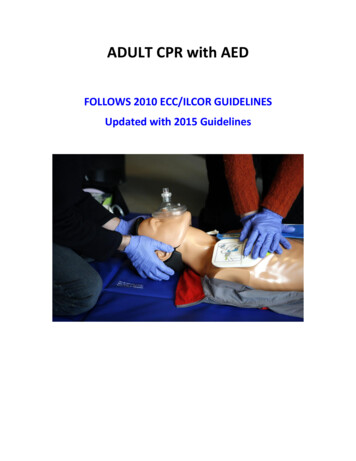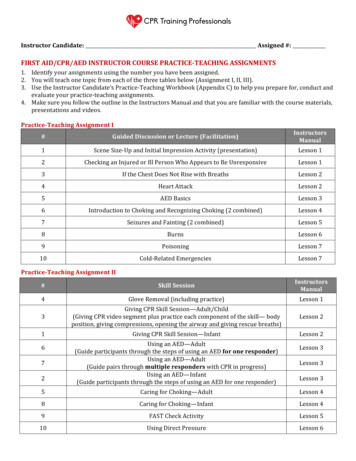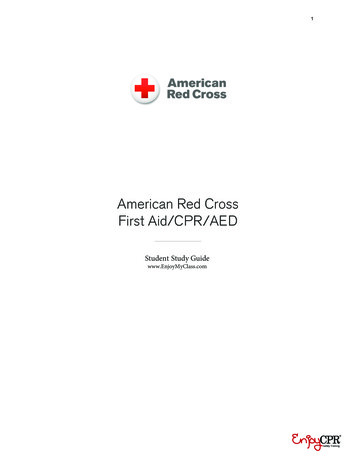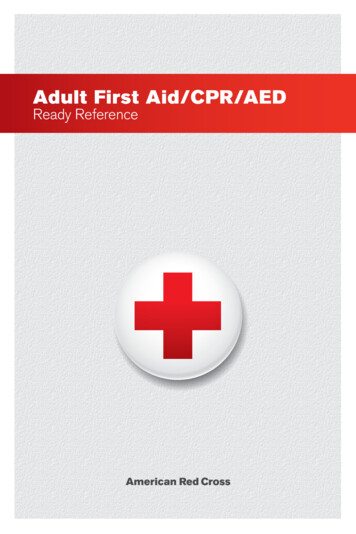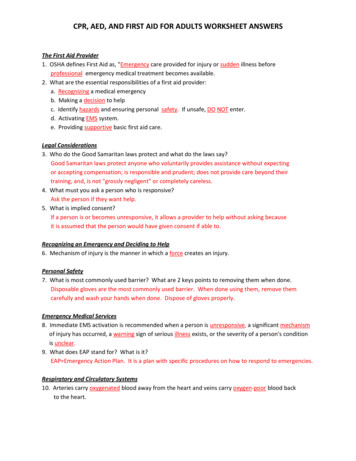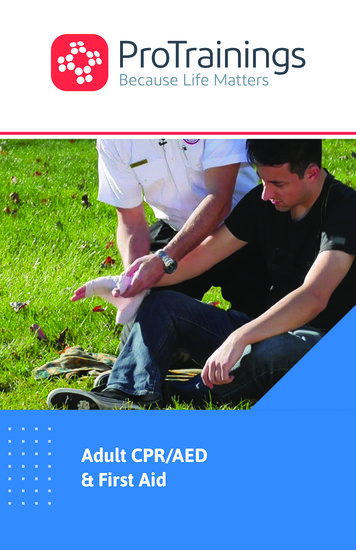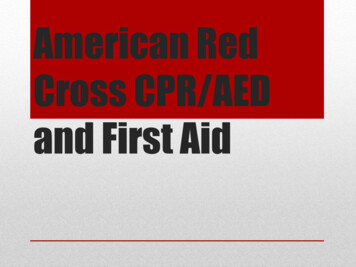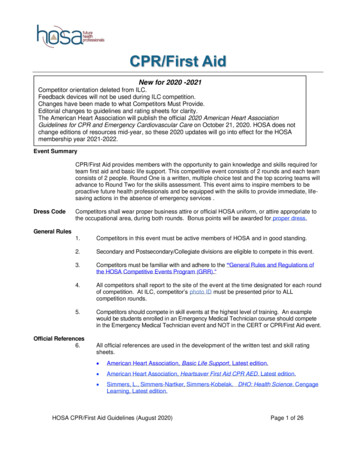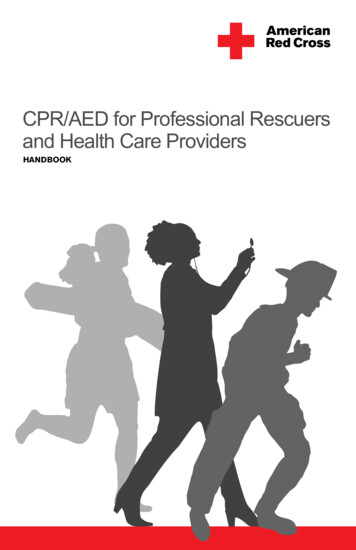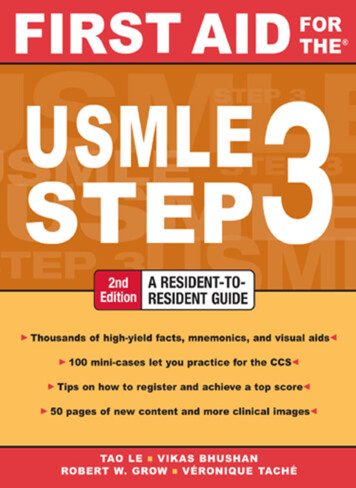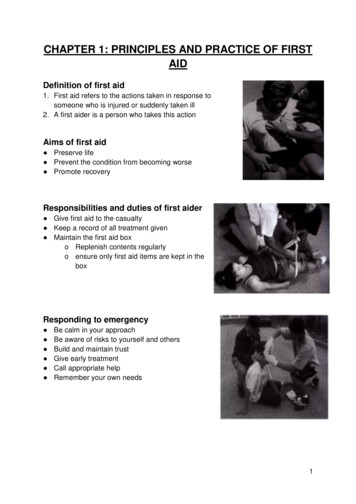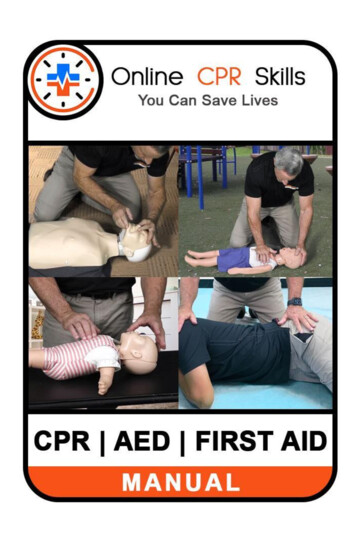
Transcription
Course Content Chain of survival / Personal protectionScene safety/ Victim assessmentCall 91-1CPR for adult, child & infantUse of a mouth barrier/face shieldAED useRecovery positionLaws/ Good SamaritanPrevention of cardiovascular diseaseRecognition and action steps for suspected heart attack and strokeChokingBleeding & ShockAsthmaAnaphylactic shock/ epi penSeizuresHypothermia/ Heat exhaustionMoving victimsThe purpose of this booklet is to provide a source for review and assistance with theCPR/AED/FIRST AID curriculum. Participants desiring CPR certification need to usewww.onlinecprskills.com to view the videos, receive instruction, and complete testing.Terminology Good Samaritan Law – states that a person acting in good faith,rendering reasonable first aid, will not be held accountable fordamages to that person unless gross willful misconduct is used. Thisperson must not have a legal duty to respond or complete the firstaid. Consent – a patient allowing you to give first aid Informed consent – you are informing the patient of theconsequences, and then the patient giving you permission toprovide first aid. Implied consent – when a patient is unconscious, it is given that ifthe person were conscious, they would request care. Abandonment – initiating care and then stopping without ensuringthat the person has the same level or higher care being rendered. Negligence – When you have a duty to respond and you fail toprovide care or give inappropriate care, and your failure to providecare or inappropriate care causes injury or harm. Universal Precautions – Using gloves, masks, gowns, etc. forevery patient every time when there is a possibility ofencountering any body fluids.1 Online CPR Skills
Chain of SurvivalThe Chain of SurvivalThe earlier these steps take place in an emergency,the better the chance of a patient’s survival.ED Recognition and Activation of EMSImmediate CPRRapid DefibrillationBasic or Advanced CareHospital CarePersonal ProtectionPutting Gloves on:Use disposable gloves when providing first aid care. If you have a latexallergy use a latex alternative such as nitrite or vinyl. Before providingcare, make sure the gloves are not ripped or damaged. You may need toremove rings or other jewelry that may rip the gloves.Removing Gloves: Remember to use skin to skin and glove to glove.Pinch the outside wrist of the other gloved hand. Pull the glove off turningthe glove inside-out as you remove it. Hold it in the gloved hand. Use thebare hand to reach inside the other glove at the wrist to turn it inside outtrapping the other glove inside.Dispose of gloves properly. If you did it correctly, the outside of eitherglove never touched your exposed skin.Use a Mouth Barrier or Face Shield:If you are going to provide rescueventilations, use a mouth barrier orface shield that has a one-way valveto prevent exposure.Online CPR Skills 2
Scene SafetyCheck the SceneKey questions to ask: Is it safe for me to help? What happened? How many patients are there? Am I going to need assistance fromEMS? Do I have my personal protectiveequipment ready to use?Assess the VictimCheck the victimTap and shout. Is there any response?look for normal breathing by looking atthe person’s chest and diaphragm. Is thepatient breathing normally?Agonal respirations are not normalbreathing. They would be characterizedas occasional gasps. There is no riseand fall of the chest or abdomen.Rookie Mistake; rushing into the scene and becoming part of theproblem rather than the solution. Take your time and get the big picture.3 Online CPR Skills
Call 9-1-1If they are not breathing, we immediatelyhave someone call 9-1-1 and havesomeone else retrieve the AED ifavailable.Now, if you are by yourself, you must call9-1-1 first before beginning CPR. Get theParamedics on the way.Information you need for the 9-1-1dispatcher What is the nature of theemergency, and is it clear andconcise? In other words whathappened. Your name, phone # and location What happened or any specialcircumstances? Are they breathing? Are they bleeding? Are they responsive? What is being done for thevictim? Have you begun CPR?Be calm and answer their questions.Arguing or trying to rush the dispatcheronly delays the response.Then grab an AED if available and headback quickly to do CPR.Rookie Mistake; calling 9-1-1 before assessing the victim and getting allthe facts.Online CPR Skills 4
Recovery PositionRecovery Position Used when a person is breathingand unconscious Helps keep airway open Allows fluid to drain from mouth Helps prevent aspiration Improves blood flow Extend victim’s arm farthest fromyou above victim’s head Place the victim's leg nearest toyou, over his other leg. Support head and neck on arm Place victim’s arm nearest to youacross his chest Roll victim away from you Position victims’ top leg so theknee acts as a prop for the body Place victim’s hand under chin tokeep airway open5 Online CPR Skills
CompressionsIf the victim is unresponsive with no normal breathing,begin chest compressions.Give 30 chest compressions at a rate of 100-120compressions per minute for all ages.Hand placement for compressions:Adult— Place the heel of your hand at thecenter of the chest with your middle finger inline with the nipple. The second hand shouldbe placed on top, with your fingers interlaced.Compress 2-2.4 inches deep.Child— Hand placement is the same as adult.You may use one or two hands in the centerof the chest between the nipples. Compressat least 1/3 the depth of the chest or about 2inches.Infant— Place two fingers on the center of thechest one finger below the nipple line.Compress at least 1/3 the depth of the chestwhich is about 1 ½ inches.Online CPR Skills 6
AirwayOpen Airway using Head tilt, Chin liftLook in the mouth to make sure the airway isclear. If you see any foreign object, sweep itout right away with your 2 fingers for an adultand one finger for a child and infant.BreathingGive 2 breaths lasting 1 second each. Watch for chest rise.Note: If not using a rescue mask, make sureyou make a tight seal over the mouth on anadult and child and pinch the nostrils closedeach time you give a breath.On an infant, make sure to cover the mouthand nose with your mouth.Give 2 gentle puffs of breath for the infant.Provide continuous cycles of 30 compressions to 2 breaths until an AEDarrives, or until advanced medical personnel take over, the victim showssigns of life, the scene becomes unsafe, or you are too exhausted tocontinue.Rookie Mistake; Not pinching the nostrils of the adult and child whendelivering 2 breaths or rescue breathing.7 Online CPR Skills
CPR SUMMARY Check the Scene for Safety Check the person for responsiveness Call 911Online CPR Skills 8
CPR SUMMARYWhen you start CPR, we want you to continue until help arrives. Butthere are times you can quit prior to first responders arriving.When to stop CPR: If the patient begins breathing When the fire dept or ambulance arrives Someone of equal or higher training can take over You, the rescuer becomes too tired to continue, you areexhausted If the situation becomes too dangerous. Civil unrest,uncontrolled traffic, lightning strikes, etc. And last, if you have been performing CPR for 30 minutes andno Advanced Life Support (Paramedics) have arrived onscene. They have been down too long to survive. Theexception to this rule is a cold water drowning or an ice orsnow rescue.9 Online CPR Skills
AED- Automated External Defibrillator AEDs are designed to shock theheart, for the heart to restart under anormal rhythm. The AED analyzesthe heart’s rhythm, states whether ashock is advised and then powersup, the operator then pushes abutton that will deliver the shock. Each minute that defibrillation isdelayed the chance of survival isreduced by 10 percent. Earlydefibrillation increases survival ratesto greater than 50%. Rescuers should begin chest compressions as soon as possible anduse the AED as soon as it is available and ready. If the available AED does not have child pads or a way to deliver asmaller dose, it is still recommended to use the AED with adult pads.With adult pads for a small child or infant, you would place one padon the center of the chest and the other on the center of the backbetween the shoulder blades.AED Considerations: Remove a patient from standing water, such as in a puddle, beforeAED use. Rain, snow, or a damp surface is not a concern. Slightly adjust pad placement so as not to directly cover the area ifthe patient has an obvious bump or scar for a pacemaker. Remove medication patches found on the patient’s chest with agloved hand. Never remove the pads from the patient or turn the machine offOnline CPR Skills 10
AED- Automated External Defibrillator Turn the machine on. Place near thehead of the victim opposite side ofthe rescuer performing CPR. Bare the chest. Dry it off if it is wet.Shave any chest hair. A towel andrazor are stored in the kit. Place one pad on the victim’s upperright chest above the nipple. Placethe other pad on the victim’s lowerleft ribs below the nipple.**Follow the directions shown on thepads for the AED pad placement. Make sure pads are pressed downfirmly. Follow AED prompts. Stand Clear. Do not touch thepatient while the AED analyzesheart rhythm If the AED says, “Shock advised,charging ,” shout, “Clear” andmake sure no one is touching thepatient. Push the shock button whenthe AED tells you to. If no shock is advised, give CPR ifthe patient is not moving and notbreathing. As soon as the shock has beendelivered, give 30 chestcompressions followed by 2 breaths.Continue cycles of 30:2 until you seesigns of life.The AED will reanalyze every 2 minutes and prompt for a shock ifneeded. The AED will deliver 3 shocks in total.11 Online CPR Skills
AED– Child and Infant Pad Placement For children under 8 years old and 55lbs. and infants, an AED with pediatricpads is preferred. If only a standard AED with adult pads isavailable, it should still be used forchildren and infants in cardiac arrest. When placing the pads on a child, thepads should not touch. For a small child or infant, the padsshould be placed one in the center of thechest and one in the center of the backbetween the shoulder blades.Online CPR Skills 12
Hands-only CPRHands-Only CPR has received a lot of press in recent years, so much so,most people think this is the new way to perform CPR. It came about as aresult when the American Heart Association updated their new CPRguidelines in 2010. It was stated as an alternative to the CPR norm of thetime which included breaths along with compressions, but in certainsituations you may be unable or unwilling to perform mouth to mouthventilations. The American Heart Association wanted to be sure you hadan alternative, which is Hands-Only.This also became a great option for the untrained civilian who wanted tohelp but never had any formal training. In fact, it is now promoted as away for the public to help. What most people do not realize, is that handsonly CPR does not apply to children or infants. It also does not apply todrowning victims, drug overdoses, or the unwitnessed collapse of anyage victim. All these victims need oxygen. So, the preferred method isstill CPR with compressions and breathing. But if you are unable orunwilling to perform breaths, you have the option of compressionsonly.Legal IssuesConsent can be expressed or implied. Expressed is when the victimacknowledges your request to help. Implied is when an unresponsivevictim is in a life-threatening situation and cannot answer for themselves.The law assumes that a victim would want lifesaving help, implyingconsent.Abandonment means leaving the victim once you have started carewithout ensuring someone else will continue equal or higher care.Negligence means not following standard practices of care when youhave a duty to act (i.e. teachers, firefighters, police, athletic trainers,lifeguards, etc.) that would cause harm or injuries.Breach of Duty caused by omission or commission. Forgetting to put adressing over the wound is an Omission. Cutting a snake bite is an act ofCommission.For those who are not professional responders your expected level ofcare is equal to your level of training.13 Online CPR Skills
Cardiovascular DiseaseCardiovascular disease causesdamage to the heart and bloodvessels. Cardiovascular diseaseoften leads to heart attack or stroke.The best way to survive a heartattack or stroke is to never have one.The key for cardiovascular disease isto focus on prevention.Cardiovascular disease is the #1killer in the U.S. The center forDisease Control reports that inthe U.S. over 650,000 people dieeach year from heart disease.You can give yourself the best chance of preventing cardiovasculardisease with proper nutrition, consistent physical activity, weightmanagement, stress management, eating proper fats and oils, andquitting smoking.Heart AttackSigns and Symptomsmay include Chest discomfortpressure, tightness thatmay radiate to jaw andarms. Nausea Sweating Shortness of breath Denial Feeling of weaknessWomen present more with shortnessof breath, extreme fatigue, or flu-likesymptoms. About a third of womenexperience no chest pain.Treatment:Recognize the signs and symptoms ofa heart attack, activate EMS. Havepatient remain in a position of comfort,offer 1 adult dose chewable aspirin,and keep the patient calm and quiet.Online CPR Skills 14
StrokeStroke is the 3rd leading cause of death in the United States. Strokes canbe one of two types: ischemic– a clot in a blood vessel that restricts orobstructs blood flow to the brain; hemorrhagic- a blood vessel thatruptures and prevents blood flow to the brain. In either case, the brain isdeprived of oxygen and tissue starts to die. The longer the stroke goesunrecognized and untreated, the more damage is done.Signs and Symptoms may include Numbness or weakness of the face, arm or leg, especially on one sideof the body.The acronym FAST helps in assessing a stroke:F– facial droopA– Arm driftS– SpeechT– Time Confusion, trouble speaking orunderstanding Trouble seeing in one or both eyes Trouble walking, dizziness, loss of balance or coordination Severe headache with no known causeTreatment:Recognize the signs and symptoms of a stroke, activate EMS, givenothing to drink or eat, and keep the patient calm and quiet. Monitor thevictim and be prepared to start CPR if necessary.15 Online CPR Skills
Conscious ChokingConscious Choking Ask, “Are you choking? If a person is unable to cough, breathe orspeak, Activate EMSAdult and Child Stand behind the victim with one foot inbetween the victim’s feet and your otherfoot behind you. Place the thumb side of your fist just abovethe victim’s belly button. Grab the back ofyour fist with your other hand. Administer abdominal thrusts by pullinginward and upward, until the object comesout, or the patient becomes unconsciousInfant Support the infant’s face and place thetorso on your forearm. Keep the infant's head lower than the feet. Administer 5 back blows between theshoulder blades with the palm of yourhand. Support the infant’s head. Turn the babyover onto your other forearm. Give 5 chestthrusts. Continue back blows and chest thrustsuntil object comes out or infant becomesunconscious.Special Circumstances: If the patient is pregnant or too large toreach around, give chest thrusts instead.Online CPR Skills 16
Unconscious Choking If you are giving someone abdominalthrusts (Heimlich maneuver) and theperson goes unconscious, lower thevictim safely to the ground. Activate EMS, send someone tocall 9-1-1 Adult, Child, and Infant - Give 30 chestcompressions Open the airway and check the mouth fora foreign object. If something is seen,sweep it out with a finger. Use the pinkyfinger for an infant. Attempt rescue breaths. If breaths do notmake the chest rise, reposition head andreattempt rescue breaths. Give 2 breaths. Do Not perform a blind finger sweep. Continue compressions, foreign body check, breathing attempts until airgoes in and chest rises. If air goes in and makes the chest rise If the victim is still not breathing normally, continue CPR with cyclesof 30 compressions to 2 breaths.17 Online CPR Skills
Bleeding and ShockBleeding Control Capillary bleeding is usually notserious and is characterized by oozingblood that is easily stopped. VenousBleeding steadily gushes largeamounts of blood but can usually bestopped with direct pressure. Arterial Bleeding is usually spurtingand is the most serious because alarge amount of blood can be lostquickly. Inspect the wound. Look for the areawhere the bleeding is coming from.Put on gloves. Use direct pressure on the wound using an absorbent pad orgauze. Add more gauze or padding if the first gauze becomessoaked. Once more gauze is applied, elevate the arm above the heart toslow blood flow and allow for clotting. If still bleeding, add more gauze and apply pressure to thebrachial artery pressure point for another 5 minutes. If you cannot control severe bleeding, consider using atourniquet.ShockShock is the body’s inability to circulateoxygen to the vital organs.Signs & Symptoms: restlessness,dizziness, confusion, cool moist skin,anxiety, delayed capillary refill time, andweakness.Treatment: Recognize, Activate EMS,keep calm, give nothing to eat or drink,maintain body heat by covering victimwith a thermal blanket. Raise the legs ifno spinal injury or fracture of the legs issuspected.Online CPR Skills 18
AsthmaAn asthma attack causes the airway tonarrow and makes breathing difficult. Asthmaattacks can be caused by environmentalfactors.Some common triggers are. Respiratory infections like the commoncold Allergic reaction to pollen, mold, petdander Exercise can also can an attack Certain foods nuts, milk and eggs can bring on attacks Air pollution, cigarette smoke, fumes from cleaning productsKnowing these triggers in advance can help you prevent an asthmaattack.Signs and symptoms. Wheezing and difficulty breathing and speaking Dry persistent cough, fear or anxious Gray-blue or ashen skin you need to take immediate action.Call 9-1-1 first, then if the victim is known to have asthma, help the victimuse their prescribed medication, usually an inhaler.Help them into a position of comfort for breathing which is usually sittingup.19 Online CPR Skills
Anaphylactic Shock / Epi pen useAnaphylaxis is a severe allergic reaction to asubstance causing your blood pressure todrop and the narrowing of your airway,making it difficult to breathe. Some things thatmight cause this include certain foods, insectvenom, medications and latex.Symptoms include shortness of breath, a rapid weak pulse, skin rashand nausea. Any rash or swelling of the face or neck should be takenseriously as this could mean the airway is swelling also affecting thevictim's breathing.Immediately call 9-1-1 and locate an Epi-pen. While the victim is in theseated position, remove the cap to the Epi-pen, and with your dominanthand, grasp the pen and place the orange tip of the pen against thevictims upper thigh, pushing until you hear or feel the click. Hold the penin place for 3-10 seconds depending on the instructions on the Epi-pen.Keep the victim in a seated position for easier breathing. If the victim isunconscious, place them into the Recovery Position.SeizureSeizures could be described as a short circuitin the brain resulting in convulsions caused bydifferent conditions including epilepsy. Whenconfronted with a seizure there are somesimple steps you can take to ensure thesafety of the victim.Try to protect them as they go to the ground. Once on the ground,move any furniture that may injure them as they are convulsing. Protectthe head by sliding something soft underneath.Time the seizure. It is especially important to know how long the seizurelasts. Since breathing is compromised during the seizure it is important toknow how long the brain was deprived of oxygen. Also, this will be one ofthe questions from the 9-1-1 dispatcher as well as the paramedics whenthey arrive on the scene.Do not attempt to move them during the seizure. Wait till the seizureends.The moment the seizure ends, check the victim's breathing. If the victimis breathing, roll them into the Recovery position. If they are notbreathing, quickly perform a head tilt chin, if they still do not startbreathing, begin CPR immediately.Online CPR Skills 20
Moving PeopleEmergency Rescue MovesIn general, a rescuer should not move a person unless it is necessary toprovide care or there is a direct danger to the person’s life. Remember toprotect the head, neck and back. Clothing DragGrasp the shirt near the shoulders. Lift upand walk back-wards dragging thepatient. Blanket DragPlace the patient on a blanket or sheet.Grasp at head end, lift and walkbackwards or crawl while dragging thepatient. Extremity DragsIf necessary, simply drag by grabbing thelegs or forearms (based on any injuries tothe limbs) and pulling.21 Online CPR Skills
Special ConsiderationsHypothermiaSpecial Considerations for HypothermiaIf the victim is unresponsive with no breathing or no normal breathing,and suspected to be in hypothermia, first aiders would follow the normalsteps for CPR and take a few extra steps. Quickly move the victim out of the cold Shield the victim from the wind or cold Do not give any alcohol to drink Wet clothes should be removed from the victim to prevent furtherheat loss Do not rub or massage the skin to warm Avoid rough movement and handle person gently Passive warming, such as warm blankets and heat packs, can beused until active warming is available with advanced medicalcare.Heat ExhaustionHeavy sweating, thirst, fatigue and heat cramps. Advanced heatexhaustion includes headache, dizziness, nausea and vomiting.Treatment includes. Move the victim out of the heat to rest in a cool place and loosenor remove their outer clothing. Raise the legs 6-12 inches. Give the victim a carbohydrate-electrolyte drink, like a sportsdrink to support rehydration. Cool the victim by placing a wet cloth on the forehead andapplying cool water spray to the skin or clothing.Online CPR Skills 22
Notes
Copyright: Disaster Survival SkillsVersion 1: 01-08-20
rskills.comwww.disastersurvivalskills.com
Jan 08, 2020 · CPR/AED/FIRST AID curriculum. Participants desiring CPR certification need to use Terminology Good Samaritan Law – states that a person acting in good faith, rendering reasonable first aid, will not be held accountable for damages to that person unless gross willful misconduct is used.
